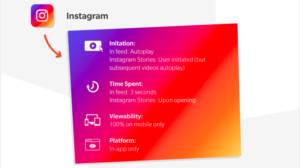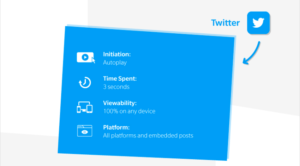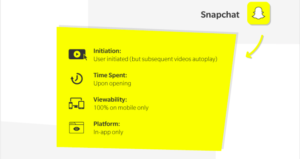How To Implement Video in Your Social Media Marketing Strategy
Video is one of the most powerful forms of content you can put out on social media.
90% of the information transmitted to the brain is visual. What’s more, visuals are processed 60,000 times faster in the brain than text.
What about a video which has been shot with 60 frames per seconds?
Inevitably, it will be a completely different story as opposed to sharing a single photo on your social media.
Or even just plain text.
In this article, we’re looking deeper into the world of video content and how you can implement it into your social media strategy.
Why use video in social media marketing?
The statistics speak clearly about video content and it’s benefits.

Studies show that 65% of the population are visual learners. This means that they need to see what they are learning through images and video. When marketing your products, you want to show how your products can make your customers’ lives better, and the benefits your product has.
And as you know, storytelling is far more simple with the help of video as opposed to images or text.
Okay. Visual content is processed faster and more thorough than text. We now know that.
But if you’re as fascinated as me by how looking at the human brain and how it works can tell us what types of content we should be putting out for optimal results for marketing purposes, you’ll love the information that comes next.
Our brains are far more engaged by storytelling with video. It’s easier for humans to remember stories that we’ve seen in visual form because our brains make little distinction between an experience we are reading about and one that is actually happening.
Why does this matter?
Because it means that with the help of a camera you can create a video so compelling that the viewers who see it visualise themselves with the product, and they see themselves having a physical connection with it.
It is proven many times that if you can get products in your customer’s hand, your chances of generating a sale increases dramatically.
While they have never held your product in their hand, your video will lead to a perception in their brain that they’ve been in contact with it.
What’s even more interesting is the following:
Content with visuals get 94% more total views!

And visual content is 40 times more likely to be shared on social networks!
Imagine the exposure that comes with it!
All achieved with a simple video!
Last but not least, 90% of online shoppers said they find videos helpful in making decisions.
By implementing video in your social media marketing, you’ll be able to better explain your products and the benefits of them, and as a result make your customers’ shopping experience with your brand easier.

1. Different platforms demand different approaches
Different social platforms demands different approaches to video.
Before you start posting video like a maniac on the different social platforms, it’s essential that you understand how video works across the different platforms, and that you need different approaches depending on which you use.
Some social platforms will work best with short videos, other will only work if you create long videos.
Another tip is to start creating videos for one or two social platforms in the beginning. This will let you fully master video creation and everything that goes into creating a compelling video.
There are two places where you can share video content on Instagram.
On Stories (as a pre-recorded video or live video) or as a regular post.
When you share a story, it will be up for 24 hours before it vanishes.
Your video can be 3 to 60 seconds long if you share your video as a regular post.
In March 2016, Instagram made a change, moving the video length limit from 15 to 60 seconds.
The length of the video is worth bringing into the equation, so you’re not standing there with a 1 and a half minute video, forced to shorten it because of Instagram’s video limit.
That’s not all…
The performance of videos on Instagram varies depending on video length.
More than you might think!
For Instagram video success, it is recommended that your videos are clear, concise, and direct. The caption of your video should be equally so.
1st Phorm does a great job with creating short and snappy videos on Instagram which their audience resonate well with.
On Instagram the total video views are shown in the bottom of the post for every to see.
When should you post video?
If you’re posting a photo on Instagram, the performance of it doesn’t vary too much depending on when it is posted.
However, when you share videos on the platform, it’s a different ball game.
Studies have found that Instagram videos should be posted during off-hours (9pm-8am EST) for optimum engagement.
The reason to this is somewhat debatable, but the most logical reason is because sound is often demanded for a full video experience, and this makes video more difficult to watch in secrecy during the work-day.
Another reason could be that people have more time to watch videos after work.
The most logical reason would be that it’s a mix of both.
How are video views counted?
Video views is the most surefire way to measure your video performance.
But not all platforms have the same way of counting views.
In fact, platforms like Facebook, Twitter, Instagram, and Snapchat are all different in the way they count views. There are 4 key factors to look at when comparing video views across platforms.

The criteria used to count views will also help you understand the true performance of your videos.

Choose an appealing thumbnail
Instagram users are scrolling through the platform at the speed of light. Every day 95 million photos are shared on the platform.
What does this mean?
It means that you need to put great emphasis on the thumbnail so that it stands out from the rest of the content in your followers’ feeds.
Facebook boasts eight billion video views per day, and Facebook Video posts have increased by 94% annually in U.S.
The latter statistic is a clear sign that video content works really well on the platform.
What’s more, as of January 2016, 500 million people are watching Facebook Videos each day.
Imagine the potential a good Facebook video has!
How does Facebook measure video views?

Facebook’s criteria of measuring a video view are fairly loose. In order to be classified as a view, videos only need to play for a minimum of three seconds, even on mute.
If you produce video on Facebook, you should pay most attention to the 10-second views.
These give a more accurate picture of how many people really watched your video.
Because Facebook’s organic reach has seen a steady decline over the years, getting traction for your Facebook video is difficult. Unless it goes viral that is.


In order to get your video seen, and to increase its chances of going viral, an investment in boosting your post might be well worth it.
When you pay to promote your video on Facebook, you can choose between three bidding options; impressions, 100% in-view impressions, and 10-second views. The 100% in-view impression is where the whole video passes on the viewer’s screen.
For optimal results, you want to opt for shorter videos on Facebook. While longer videos can get good results, you want to catch the interest of every single person who comes across your video and not lose them because they lose interest. On Facebook, every organic view is highly valuable.
Twitter is a paradise for videos if you know how to create them and share them properly.
Because Twitter is first and foremost a social platform that is driven by text, it’s a platform which makes content digestion more difficult for its users. This is with the fact that written content is processed a lot slower than visual content.
But because Twitter is mostly driven by the written word, it makes it a perfect place for video – and to stand out with the help of it.
That’s why the statistics around video on Twitter look so promising.

In fact, native video on Twitter (Videos uploaded directly to the platform) drives more engagement than overall engagement than this-party videos shared on Twitter.
Based on the impressive fact above, it’s not surprising that the majority of Twitter users (82%) watch video content on Twitter.
In December 2016, Twitter introduced live video, which means that there are now two ways you can share video content on Twitter.
How does Twitter measure video views?

No ideas on what videos to create?
Twitter users report that they want to see more of the following video types:
- Breaking news (64%),
- Clips from live sports shows (54%)
- Clips from TV shows (50%).
They also report that they want to see more videos from the following users: celebrities (45%), other users (40%) and brands (37%).
37% of Twitter users wants to see more videos from brands. That’s quite a lot!
This just shows that the interest for video on Twitter is high, and that you’ll be able to generate some great results if you give your audience what they want.
Moreover 70% of users say that they watch videos that appear in their timeline. The conclusion is that people aren’t actively searching for videos, instead digest them where they appear.
What you should learn from this is to not create long, boring product videos, because people will continue scrolling.
Twitter users might love video content, but the fact that the human has a very (very!) short attention span still remains.
That’s why it’s important that you create a video that grasps the viewer’s attention within the first few seconds. Fail to do so and they’ll continue scrolling.
Unlike its competitors, Twitter does not showcase a video view counter next to a video post.
YouTube
YouTube is the second largest search engine in the world. It is also the best place for evergreen content.
As opposed to Twitter where 70% of people watch videos that appear on their timeline, 20% of YouTube users say they only watch videos that they discover on YouTube.
In contrast, 63% say they search for videos on YouTube to find specific videos on the platform.
This shows how important video optimisation is. Video optimisation means optimising your videos with descriptions and keywords so they’ll end up more often in people’s search results, thus leading to more video views.
For YouTube success, storytelling is vital.
On a platform where 400 hours of video are uploaded every minute, and 1 billion total videos (as of 2015) have been shared, there’s no question that getting your video seen is a challenge.
How does YouTube measure video views?

There are many brands who have successfully implemented YouTube in their social strategy – and gotten impressive marketing results from it.
GE (General Electrics) is one of those examples. GE’s YouTube channel offers transparency, information, and experimentation.
On their YouTube channel, you can watch their commercials, see interviews with visionaries, engineers, and scientists learn about future and current technology, and be generally amazed by everything they do.
GE have successfully created a YouTube channel that is a go-to source for people interested in engineering, science, and future technology.
And that’s what YouTube is about! Creating videos that attracts people because they’re getting something from your videos. You don’t just want to create videos that blatantly promotes your products. You want to create videos that provides value, no matter if it’s knowledge, entertainment, or just a good laugh.
The marketing results from GE’s YouTube channel doesn’t come from shoving down promotion videos down their viewer’s throats. They come by attracting people with content their audience finds valuable.
In writing moment, GE has been able to accumulate 154,043 subscribers and a total of 50,341,779 views.
That’s a lot of exposure!

As with any social platform, the length of the videos you share on YouTube is important.
You want your videos to be long enough to include all the necessary information, while also being short enough so your audience doesn’t lose interest.

As you can see in the graph from Wistia, the longer your YouTube video is, the fewer people will watch it.
On YouTube, quality is extremely important. If your video is low quality, people won’t hesitate to hop on another of the billion+ videos on the platform.
Snapchat
Snapchat is almost purely based on visual content. Therefore, it is vital for success on the platform.
Different from how the other social platforms work, the content you share on your Snapstory will only be up for 24 hours.
This means that you have to be active every single day on the platform with fresh new content so you’re never forgotten.
What it also means is that you need to have the resources it takes to share new videos every single day. If you don’t, opting for another alternative might be a better idea.
The flip side is that each video on Snapchat can be a maximum of 15 seconds long, and they’re super easy to record.
In addition, 3 million snaps are being sent, and 1o billion videos are viewed every single day.
How does Snapchat measure video views?

Snapchat is a bit different from its social media rivals. Because the length of a Snapchat video is 15 minutes (at most), and that they only exist for 24 hours, visual storytelling is its big advantage.
Many brands use the platform to show in-depth behind the scenes look into their offices, worksite, products, and co-workers – this reducing the gap between brand and customers.
Once again, General Electrics is a great example of a brand who successfully implements Snapchat into their social media marketing strategy, and see great results from it.

2. Define your goals with video
Now that we’ve had a look into the most popular social media platforms and how they differentiate from each other, and you’ve hopefully chosen one or two to go with, it’s time to determine your goals with video content.
Video can achieve many different marketing objectives, and it’s important that you set your eyes on one or two because this will make your video creating easier – both long and short-term.
It will also prevent you from wasting time and resources towards creating a type of video that did not align with the type of goals you wanted to achieve.
With your video content, do you want to:
- Increase website traffic
- Gain video views
- Gain shares
- Get media coverage
- Improve your customer service and engagement
- Increase brand awareness
Or something completely different?
When you’ve set your goals, think about what types of videos you need to create to achieve those goals.
If you want to create videos for customer service, you probably need to create guides or informative videos that answers common questions your customers have.
If you want to gain news coverage, you probably have to create videos that are out of the box and highly unique.
Dollar Beard Club is an example of a brand who has reached tremendous success with their YouTube videos and gotten tons of media coverage as a result.
There are two main reasons they’ve reached such success with their videos:
- They create videos that align with their own and their customer’s values (more on that later).
- They create consistent-themed videos (more on that later).
3. Create a consistent visual theme and style
Just like when creating a social media content strategy for images, you need a strategy for your videos.
Again, your videos should reflect the objectives you want to achieve with your videos.
There are many ways you can achieve a consistent theme across your videos. The thing that most brands who have succeeded with video marketing have in common is that the content differs from video to video, but the structure and style remain the same.
See it as an ongoing process of creating videos that achieves your goals.
The Swedish grocery shop ICA has had incredible success with video by creating commercials in a series-styled form, with the same characters appearing in each commercial. The video style remains the same throughout each commercial, taking place in a grocery shop, showing “This week’s special prices”, leading to a video series that people love.
In fact, the series has been so successful that it has proceeded since 2001 when it was first launched.
By deciding on a particular theme, and sticking to it, people know what to expect, and when they see a video from you, they’ll be able to instantly recognize it.
4. Create videos that reflects your brand’s values
Again, this continues on your goals with video.
The reason why Dollar Beard Club’s videos are so successful is that they’re completely aligned with the brand’s values.
The result of this is that it speaks to its target audience in a way that appeals to them.
You can learn a lot of what type of videos you should share with the help off your social media content strategy. By now, you’ve probably started sharing content with a certain type of style that reflects how you want others to perceive your brand.
When you ask yourself what your target audience finds appealing, and what content reflects your brand, the answer should be similar.
At least if you’ve done your customer identification properly.
Because ultimately, it is your target audience you are trying to reach with the help of your videos.
Dollar Bear Club hasn’t reached success in creating videos including swear words, humor, and explicit content because their target audience hates it.
More like the opposite!

It’s a clear sign that they know exactly what their audience finds amusing, but it’s also a clear sign that they are just doing their thing and the result is content that their audience love.
This is what Chris Stoikos, co-founder of DBC said about the reason behind the success of DBC’s videos:
“We aren’t trying to mimic other successful companies, or put on a non-genuine face, we’re just being who we truly are. These videos work because our members feel that they’re a part of something much bigger than themselves: the beard movement.”
5. Invest in the right equipment
The quality of your videos is super important.
And for beginners, video can be intimidating.
You have to buy camera, microphone, editing software, actors, studio, lightning equipment, and so on.
The list never ends.
Of course, you don’t have to invest tens of thousands of dollars in camera equipment, but you should be highly aware of the fact that quality matters.
The good news is that nowadays, you don’t need to invest that kind of money to create high-quality video.
In fact, a few hundred dollars and knowledge is all you need to create professional-styled videos.
If you’re willing to invest your own time instead of hiring a media company, video creation doesn’t have to be much more expensive than the other content you are producing for your social media.
The key to creating successful video is more about knowing what type of content your audience likes than it is anything else. You can have the most expensive equipment but still create videos that no-one wants to watch.
This is the minimum equipment you ned to produce great quality video:
Camera: iPhones have an incredible video quality compared to a few years ago. The market is also full of cameras that can produce amazing content at a low price.
Editing software: Most video productions won’t need an advanced editing program like Sony Vegas or Final Cut Pro. Often times, you’ll manage just fine with free editing softwares. In fact Windows computers have a pre-installed editing software called Moviemaker, and Apple computers have an editing software called iMovie.
Microphone: If you’re creating video with sound, getting a good microphone is recommended. Most of the time, the built-in microphone on your smartphone won’t do the job at a good enough quality.
Tripod: If you’re looking to dramatically improve the quality of your videos, a tripod is to recommend. Shaky videos is a clear sign of a low-quality video. Luckily, you can get a tripod that does the job for just a few bucks.
Lightning: Lightning does a huge difference in the quality of your video. Invest in good lightning and you’ll dramatically improve the quality of your videos.
Conclusion
Video is increasing dramatically in popularity.
The fact that 90% of the information transmitted to the brain is visual, alone should convince you to start producing video on social media.
Video allows storytelling in a way that is difficult with both written content and photo.
The evolution of video also shows a trend that video is getting far more popular, and will continue to be so for a long time.
With many brands building their brands solely with the help of video content, and large corporates generating tremendous marketing results with it, what are you waiting for?
Set up your video content strategy today.
Are you creating video for social media today?
Why/why not?
Have you had any success with it?



